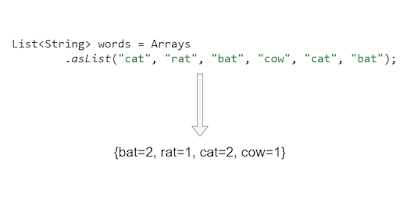Example 1
import java.util.Arrays;
import java.util.List;
import java.util.Map;
import java.util.function.Function;
import java.util.stream.Collectors;
public class Main {
public static void main(String[] args) {
List<String> words = Arrays
.asList("cat", "rat", "bat", "cow", "cat", "bat");
// For Long values
Map<String, Long> result = words.stream()
.collect(Collectors.groupingBy(Function.identity(),
Collectors.counting()));
System.out.println(result);
}
}
- The List interface in Java provides a way to store the ordered collection. It is a child interface of Collection. It is an ordered collection of objects in which duplicate values can be stored.
- The asList() method of java.util.Arrays class is used to return a fixed-size list backed by the specified array. This method acts as a bridge between array-based and collection-based APIs, in combination with Collection.toArray().
- A Map contains values on the basis of key, i.e. key and value pair. Each key and value pair is known as an entry. A Map contains unique keys.
- A stream is a sequence of objects that supports various methods which can be pipelined to produce the desired result. A stream is not a data structure instead it takes input from the Collections, Arrays or I/O channels.
- Java Stream collect() performs a mutable reduction operation on the elements of the stream. This is a terminal operation.
- The groupingBy() method of Collectors class in Java are used for grouping objects by some property and storing results in a Map instance. In order to use it, we always need to specify a property by which the grouping would be performed.
- identity is a static method of the Function interface that always returns the input argument.
- Collectors counting() method is used to count the number of elements passed in the stream as the parameter. It returns a Collector accepting elements of type T that count the number of input elements. If no elements are present, the result is 0. It is a terminal operation.
Output:
{bat=2, rat=1, cat=2, cow=1}
Example 2
import java.util.Arrays;
import java.util.List;
import java.util.Map;
import java.util.function.Function;
import java.util.stream.Collectors;
public class Main {
public static void main(String[] args) {
List<String> words = Arrays
.asList("cat", "rat", "bat", "cow", "cat", "bat");
// For Integer values
Map<String, Integer> result = words.stream()
.collect(Collectors.groupingBy(Function.identity(),
Collectors.summingInt(e -> 1)));
System.out.println(result);
}
}
- The List interface in Java provides a way to store the ordered collection. It is a child interface of Collection. It is an ordered collection of objects in which duplicate values can be stored.
- The asList() method of java.util.Arrays class is used to return a fixed-size list backed by the specified array. This method acts as a bridge between array-based and collection-based APIs, in combination with Collection.toArray().
- A Map contains values on the basis of key, i.e. key and value pair. Each key and value pair is known as an entry. A Map contains unique keys.
- A stream is a sequence of objects that supports various methods which can be pipelined to produce the desired result. A stream is not a data structure instead it takes input from the Collections, Arrays or I/O channels.
- Java Stream collect() performs a mutable reduction operation on the elements of the stream. This is a terminal operation.
- The groupingBy() method of Collectors class in Java are used for grouping objects by some property and storing results in a Map instance. In order to use it, we always need to specify a property by which the grouping would be performed.
- identity is a static method of the Function interface that always returns the input argument.
- The summingInt() method returns a Collector that produces the sum of an integer-valued function applied to the input elements. In other words - it sums the integers in the collection and returns the result. In the case of no input elements, the return value is 0.
Output:
{bat=2, rat=1, cat=2, cow=1}










